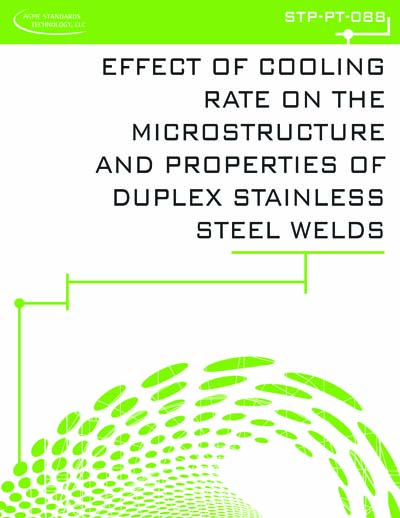Most recent
ASME STP-PT-088-2017
Effect of Cooling Rate on the Microstructure and Properties of Duplex Stainless Steel Welds
Duplex stainless steels are thermo-mechanically processed in order to produce microstructures that contain an equal balance of ferrite and austenite. The balanced microstructure affords duplex stainless steels the mechanical and corrosion properties that make them desirable for a wide range of applications. The duplex stainless steels are generally gathered into one of four alloy groups: lean duplex, duplex, super duplex and hyper duplex. These alloy groups are defined primarily on the basis of corrosion resistance, specifically the Pitting Resistance Equivalent Number (PREN). Section IX of the American Society of Mechanical Engineers (ASME) Boiler and Pressure Vessel Code (BPVC) is an internationally recognized weld qualification code. Section IX of the BPVC (Section IX) categorizes base materials into P-numbers which are dependent on the alloy type and composition. Section IX further separates ferrous materials into Group numbers which differentiate similar alloys by the materialÆs toughness properties. Section IX considers the four duplex stainless steel categories to be the same P-number and Group number which would imply that the different duplex stainless steels are comparable when it comes to chemical composition, weldability and mechanical properties including toughness. Duplex stainless steel base metals achieve the balanced microstructure and proper phase balance through chemical composition controls, heat treatment and cooling rate control. Use of an annealing temperature where equal proportions of ferrite and austenite are formed followed by rapid cooling to maintain that phase balance is used to develop microstructures with a nominal 50/50 balance of ferrite and austenite. Since welding creates a range of thermal cycles with different peak temperatures and cooling rates an unequal phase balance may exist in the different heat-affected zone (HAZ) regions. It is known that high ferrite levels in the HAZ microstructure can result in a reduction in the toughness and corrosion properties of the HAZ relative to the base metal. Unlike the weld metal where ferrite to austenite balance can be controlled by proper filler metal selection (composition control) the ferrite to austenite balance in the HAZ is primarily a function of cooling rate. The cooling rates in the HAZ are a function of the welding heat input, material thickness, and preheat and interpass temperatures. The objective of this project was to determine the effect of variations in cooling rate on the microstructure and toughness of the HAZ of duplex stainless steel alloys 2003, 2101, 2205, 2304, 2507, and Zeron 100. The variation in cooling rate was achieved using both thermal simulation and heat input control in actual welds.
Content Provider
American Society of Mechanical Engineers [asme]






